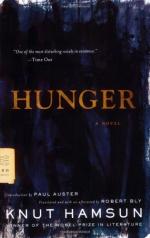|
This section contains 11,960 words (approx. 40 pages at 300 words per page) |

|
SOURCE: Riechel, Donald C. “Knut Hamsun's ‘Imp of the Perverse’: Calculation and Contradiction in Sult and Mysterier.” Scandinavica: An International Journal of Scandinavian Studies 28, no. 1 (May 1989): 29-53.
In the following essay, Riechel studies two of Hamsun's early novels, noting that the narrative effects in both Hunger and Mysteries are achieved from a combination of ambiguity, irony, and self-contradiction.
Nietzsche once wrote that becoming accustomed to irony and sarcasm spoils one's character: in the end one resembles a snapping dog that besides knowing how to bite has learned how to laugh1. Perhaps such habituation spoiled Knut Hamsun, who in his life and in his art always seems to have manoeuvred for the last laugh, to the fascinated discomfort of his readers. Hamsun's ‘insistence on ambiguity’, to use Robert Ferguson's words, ‘his rejection of certainty, his juggling with lies that turn out to be true, and truths that turn out...
|
This section contains 11,960 words (approx. 40 pages at 300 words per page) |

|


